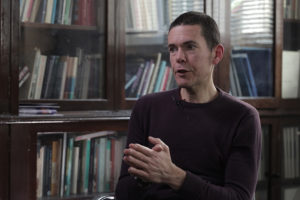Forest Degradation
Geographer Mathias Disney on the deforestation, forested environments and what is needed to reduce deforestati...
Glaciology is the study of all the ice on our planet in all its forms, which could be snow in your garden or the big ice sheets in Antarctica. The study of the ice is a sort of thing that glaciologists do. It began over a hundred years ago, usually with the study or the exploration of some polar regions: people go and be adventurous going into the Alps, looking at the glaciers in the Alps, exploring the Antarctic, exploring the Arctic, usually for commercial purposes. People would go into the Southern Ocean to look for whales and seals for oil; they were looking into the Arctic for the Northwest Passage for shipping routes. But as they did so, they became more scientifically interesting as places because of their massive ice sheets, the huge ice cover that exists.
Glaciology and ice on the planet can take several forms. You can have snow: people understand glaciology because they know about snow, so that’s one element of it. In the Arctic and in the Antarctic on the ocean, you get a very thin layer of ice that developed about a metre or so thick: it’s called sea ice, and it grows in the wintertime when it’s dark and gets really cold, and it shrinks in the summertime when the Earth warms up, and the oceans get a bit warmer. Then there’s land ice. On land you get ice, which forms by snowfall, and if the snow can last a year or two, then it starts to get denser and turn into ice. In the upper regions of mountains, ice forms as glaciers occupying valleys within the mountains themselves. So in the Alps, in many regions, you get lots of glaciers. In the mountain regions you get glaciers, and they’re quite small, and they occupy little valleys.
Occasionally, glaciers get much bigger, and they can occupy either an entire valley or they could subsume a valley, and when they do that, they turn into ice sheets. There are two massive ice sheets on the planet: one is in Greenland, and the other is in Antarctica.
If the Greenland ice sheet melted, all that water that was in the ice would be in the sea, and the sea level will be seven metres higher than it is now all around the world. If the Antarctic Ice Sheet was to melt, then sea level will be over 60 metres higher all around the world.
So, the study of ice on our planet is quite important to understand what is going to happen or not. We use various techniques to measure the ice and to understand how it behaves. The interesting thing about ice is that it does flow: it’s a solid, but if you apply a lot of stress to it over a long time, it will start to flow very slowly. There are three ways in which a glacier can flow: one is by the deformation of the ice itself, so it just slowly flows downhill in a nice, understandable kind of way. If there’s water at the bed of the glacier, underneath it, then the glacier can start to slip, and you get sliding takes place. And if there is sediment underneath the glacier and that sediment is wet, then the strength of that sediment is very low indeed, and the glacier can essentially move over a bed which has no strength at all, so it simply glides over the sediment. Glaciers can flow that way, and parts of ice sheets can flow that way as well.
So glaciers are ice, but the interaction with water is critical. They start to flow more quickly where there is water, and so understanding where the water’s forming, how quickly it’s forming, how that water is getting underneath a glacier is a major topic for us right now. So we use theory to understand how ice is going to flow, we use measurements to understand how it’s going to flow, and we also use computer models as well because computer models tell us about the past, how things have behaved in the past, and they tell us about the future.
In glaciology, the past is actually quite important to us: only 20,000 years ago was the last ice age; there was a time when there was ice over Scandinavia, over Great Britain, continuous ice sheets over lots of parts of northern Russia, a massive ice sheet over North America as well… Of course, all those ice sheets have now disappeared and what they’re left behind is this wonderful network of evidence to tell us that they were once there in terms of the geology that they left behind. So we can work out where the ice sheets used to be based on the geology, and we can use numerical modelling to reconstruct what those ice masses once looked like, and we can get those right. Once we understand the past and are able to model the past and understand the present (through all the measurements, we understand the present as well), what we can then do is think about how those ice sheets and glaciers are going to change in the future.
So our models are quite good now, we’ve got good theory which details how they flow, we’ve got lots of measurements which details about the surface of the ice, about the thickness of the ice and all of those sort of things and we have brilliant models which tell us how they’re going to change in future.
So, at the moment, there are two major ice sheets, Greenland and Antarctica, and there are roughly 300,000 other glaciers. And it’s a reasonable question to say, where did they appear from? Where did they start? There are a number of things to answer that question. The ice sheets over Greenland and Antarctica have been around for hundreds of thousands of years; in Greenland, probably, it was much smaller about 125,000 years ago than it is now, and maybe parts of Antarctica were also smaller about that time. But they were also persistently glaciated for several million years in those regions. The smaller glaciers on the planet grow and shrink much more quickly, so in the Ice Age, the glaciers would have expanded quite a lot, and they would have retreated when we got into the interglacial where we are right now.
So the reason to study glaciology is, firstly, that it’s interesting, it’s curious to study ice, some of the least explored parts on our planet of glaciated regions. So it’s interesting scientifically to find out about them. But there’s another driver, and that is because if the ice melts, that water goes into the sea, and the sea level goes up. Understanding future sea level change is one of the major concerns for societies all around the world: there are 250 million people living very close to the ocean right now, and if the sea level goes up by a metre or two, they’ll become displaced, and they’ll have to move somewhere else. So it’s a major problem.
We asked ourselves a number of questions in glaciology: how likely is that to happen? How likely is it to get one or two metres of sea level change, say, in the next hundred or so years? Well, we can measure and monitor how the ice is behaving now, and what we see is all the glaciers are melting. In West Antarctica, the ice is shrinking, and in Greenland, the ice is losing mass right now. We can think about the past as well: how likely is it that we will get a metre or two of sea level rise? Between the last ice age 20,000 years ago and the period in time that we are now, the interglacial between ice ages sea level went up because of the melting of the ice by a hundred and twenty metres in about 10,000 years: that was 1.2 metres every century for that entire time.
So you put it in context: we’ve got two massive ice sheets on the planet now. The precedent from the past is when the world warms, the ice melts, and the sea level goes up, and the lesson from history (not very far back in history, just 20,000 years ago) is that the sea level can go up by tens of metres at a rate of about a metre or two every century. The rate of sea level change going on right now is about 32 centimetres per hundred years. The interglacial glacial transition is about 1.2 metres, so we are within an order of magnitude in that.
But the thing to note is that the rate of sea-level rise is going up: it was at around about 8 centimetres per hundred years at the end of the 19th century, it was at about 20 centimetres per hundred years in the middle of the 20th century and now it’s at 32, and that weight is going to continue for sure.
So, the only way to predict the future realistically is with the models, and all the models will point to further ice sheet melting. Sea level change of half a metre or more by the end of this century is highly likely; sea level change of a metre or more by the end of the century is completely possible. So, the big question in glaciology right now is how the big ice sheets, Greenland and Antarctica, are going to change. So we have some models that are predicting that they will change, but what are the processes that could cause that change? The processes are going to be important because they all tell us how quickly the ice will melt.
The big issues in Antarctica, for example, are around the floating parts of ice in Antarctica. So the grounded ice, the ice that’s stuck on the bed, is very thick, three or four kilometres in places, but as you get closer toward the edge of the ice sheet, the ice starts to thin, and in places where it’s in water that ice becomes a float. And once it’s floating, it’s called an ice shelf. The ice shelves are very important for the stability of ice in Antarctica: they hold back the grounded ice, and they act as a backup force to keep that grounded ice upstream from flowing too fast into the ocean. The thing is, you can melt the ice to cause sea level change, but you can also flow it into the ocean. Once the ice is floating, it’s already displaced, it’s weighing water according to Archimedes’ principle, and the sea level rise has already happened. That ice can melt in its own time; it could take a hundred years or it could take a thousand years; it doesn’t matter: the sea level rise has already happened.
So that’s the process by which you can get rid of an ice shelf really quickly, and that’s what we’re worried about in Antarctica. How many of these big ice shelves that are protecting the very large volumes of ice grounded upstream are vulnerable right now? This is something that, twenty years ago, we weren’t really researching too much, but it’s becoming really important. The more we learn about ice shelves in Antarctica, the more that we start to see there is water in some of them. We don’t yet know whether the structure of those ice shelves is weakened, but that’s a hot topic at the moment to understand because if the ice shelves disappear, then the ice starts to flow more quickly into the ocean, and then we get much more sea level rise.

Geographer Mathias Disney on the deforestation, forested environments and what is needed to reduce deforestati...

Geographer Anson Mackay on the ecosystem services, the demands on freshwater around the Earth and the decline ...

Historian Valerie Hansen on cultural exchange, the history of the Silk Road, and the historical documents that...